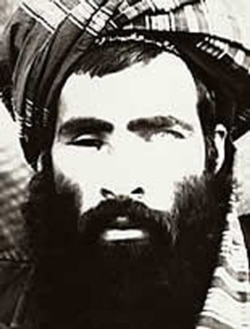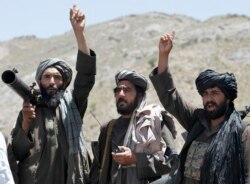When most of Afghanistan was under Taliban rule in the late 1990s, the fundamentalist regime drafted a new constitution.
The document was never officially ratified, and it was unclear how much of it was ever implemented before the U.S.-led invasion in 2001 toppled the extremist Islamic group from power.
But the constitution offers a glimpse into what kind of government the militant organization envisages as it prepares to negotiate a future power-sharing arrangement with the current Afghan government led by President Ashraf Ghani.
A political settlement made by the disparate Afghan sides is a key component of the peace deal signed by the United States and the Taliban on February 29 that is aimed at ending the 18-year war.
Under the deal, foreign forces will leave Afghanistan in exchange for counterterrorism guarantees from the Taliban, which has agreed to launch direct negotiations with Afghan officials for a permanent cease-fire and a power-sharing formula to rule the country.
Since 2001, the Taliban insurgency has vowed to drive out foreign forces and overthrow the Western-backed government in Kabul. But even as it seemingly pursues peace, it been vague about what kind of postwar government it envisions in Afghanistan.
Radical Islamic Seminaries
The Taliban emerged in 1994 following the end of the Soviet occupation of Afghanistan.
The predominantly ethnic Pashtun group first surfaced in ultraconservative Islamic seminaries in Pakistan, where millions of Afghans had fled as refugees.
The seminaries radicalized thousands of Afghans who joined the mujahedin, the U.S.-backed Islamist rebels who fought against the occupying Soviet forces.
The Taliban appeared in the southern city of Kandahar, Afghanistan’s second largest, in 1994, two years after the mujahedin seized power in the country. Infighting among mujahedin factions fueled a devastating civil war that killed more than 100,000 people in Kabul alone.
The Taliban promised to restore security and enforce their ultraconservative brand of Islam. They captured Kabul in 1996 and two years later controlled some 90 percent of the country.
In 1998, Taliban leader Mullah Mohammad Omar assembled some 500 Islamic scholars from across the country to draft a new constitution for the country.
After three days of deliberations, the scholars drafted a 14-page document -- the first and only attempt by the Taliban to codify its views on power and governance.
'Intensely Religious Roots'
In the document, power was centralized in the hands of an "Amir ul-Momineen," or leader of the faithful. This supreme leader was the head of state and had ultimate authority. This was Mullah Omar, the Taliban’s spiritual leader and founder.
The constitution did not describe how such a leader would be selected or for how long he could serve. But it said the supreme leader must be male and a Sunni Muslim.
An Islamic council, handpicked by the supreme leader, would serve as the legislature and implement laws and policy. The government, headed by the head of the council of ministers -- a quasi-prime ministerial position -- would report to the Islamic council.
Under the constitution, Sunni Islam was to be the official state religion, even though some 15 percent of the population are Shi’ite Muslims.
The document stated that no law could be contrary to Islamic Shari’a law.
The constitution granted freedom of expression, women’s education, and the right of a fair trial, but all within the limits of the Taliban’s strict interpretation of Shari’a law.
It is unclear how the document shaped the Taliban’s draconian laws and brutal policies during its Islamic Emirate, the official name of the Taliban regime that ruled Afghanistan from 1996-2001.
The Taliban banned TV and music, forced men to pray and grow beards, forced women to cover themselves from head to toe, and prevented women and girls from working or going to school. The Taliban amputated the hands of thieves, publicly flogged people for drinking alcohol, and stoned to death those who engaged in adultery. Executions were common.
Andrew Watkins, a senior analyst for Afghanistan at the International Crisis Group, said the draft constitution reflects the “Taliban's intensely religious roots” and reveals the importance placed on a “centralized authority” for a group that was “founded on a mission of restoring order to the country.”
The document was littered with contradictions and was never ratified. It was republished in 2005, a year after Afghanistan adopted a new constitution. But the document has disappeared from Taliban discourse in recent years.
“That may have been due to internal debate over certain articles, or just reflective of the group's inclination to remain flexible in its policies, in part perhaps to prevent internal divisions over policy differences,” said Watkins.
'Monopoly On Power'
As an insurgent group, the Taliban has preserved some of its key principles since it was overthrown in 2001.
Power is still centralized in the hands of an all-powerful leader, who oversees a shadow Taliban government in Afghanistan. The Taliban still enforces its strict interpretation of Islam in areas under its control. And it still regards Shari’a as the supreme law.
But analysts say the past two decades have changed how the Taliban views power.
The Taliban overcame a succession crisis after the death of Mullah Omar, has fended off competition from the global appeal of the Islamic State (IS) extremist group, and has remained a relatively coherent fighting force despite its 18-year war against foreign and Afghan government forces.
“The group now operates in a strange combination of increasingly centralizing its control over its own membership, while also allowing it to decentralize in other ways,” said Watkins.
The Taliban has claimed recently that it is not the same group that ruled Afghanistan in the 1990s.
In a public statement, the Taliban said it does not want to reestablish its Islamic Emirate and has attempted to project a more reconciliatory image.
But the Taliban’s ambiguity on women’s rights, free speech, and elections -- key democratic tenets introduced in Afghanistan since 2001 -- has raised fears among many Afghans that the extremist group will attempt to restore its severe regime.
The Taliban said in January 2019 that they are not seeking a "monopoly on power" in a future administration in Afghanistan but are looking for ways to coexist with Afghan institutions, in what was seen as the militants’ most conciliatory statement to date.
A month earlier, Taliban spokesman Zabiullah Mujahid said “if peace comes and the Taliban returns, then our return will not be in the same harsh way as it was in 1996.”
The Taliban said in February 2019 that it is committed to granting women their rights and allowing them to work and go to school, but only as long as they do not violate Islam or Afghan values.
But in the same statement, the Taliban also suggested it wants to curtail the fragile freedoms gained by women, prompting a wave of concern from rights campaigners.
Analysts said the Taliban’s great ambiguity on key issues reflects the divisions within the group.
The Taliban’s political leadership based in Pakistan is believed to be more open to an accommodation in assuming power under a peace deal.
Meanwhile, hard-line military commanders on the battlefield in Afghanistan are reluctant to budge on their demands for a full restoration of the Islamic Emirate.
“There is a cocktail of views among the Taliban on power and governance,” said Javid Ahmad, a senior fellow at the Washington-based Atlantic Council.
“More than anything, Taliban leaders need an intra-Taliban dialogue to settle their conflicting views about a future Afghan state,” Ahmad added.
There are also intense differences among the Afghan political elite.
Pashtuns, the largest ethnic group in Afghanistan, generally support a centralized state that guarantees their control of the government. But non-Pashtuns, which constitute a majority of the population, believe too much power of the state is left in the hands of one individual, and support decentralization because it would enshrine a more inclusive and equitable distribution of power.
'Incredibly Difficult'
Direct talks between the Taliban and an Afghan negotiation team over a permanent cease-fire and a power-sharing arrangement were expected to start on March 10.
But the launch of the negotiations has been delayed due to disputes over the release of Taliban prisoners and the formation of Kabul’s negotiating team.
Even when intra-Afghan negotiations begin, many expect them to be complex and protracted, possibly taking years, considering the gulf between the sides on policy and distributing power.
“It will be incredibly difficult to get the two parties to come up with compromises on every issue of governance,” Ahmad said, although he added that there were also reasons for hope.
WATCH: Afghan Women Fear Taliban Peace Deal Will Erode Freedoms
Both the Taliban’s political vision and the Afghan political system are modeled on the centralization of power and the supreme role of Islam.
Afghanistan’s 2004 constitution prescribes that "no law can be contrary to the beliefs and provisions of the sacred religion of Islam" and sometimes appears at odds with more liberal and democratic elements within it.
Power is in the hands of a heavily centralized government. The president has the right to appoint and fire governors, mayors, police chiefs, district governors, and senators and has a tight grip on the country’s finances and how funds are spent and distributed.
“There is much more common ground in the legal and governance systems of these two than many of their supporters, on either side, care to admit,” said Watkins.









